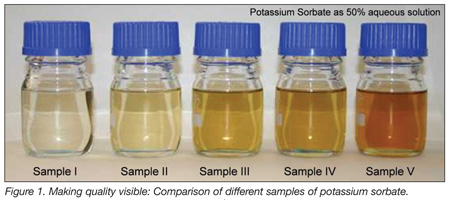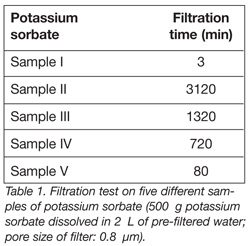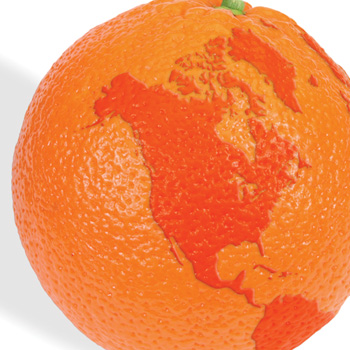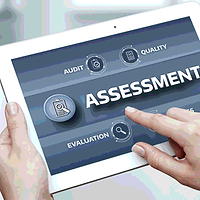In the present era of globalization, international trade in food ingredients is growing at an unprecedented rate. Food companies are now in a position to purchase ingredients and additives directly from an ever-increasing range of suppliers located almost anywhere in the world. However, this enormous degree of freedom has a very serious downside in that food companies run the risk of purchasing ingredients that possibly may not always satisfy quality demands or even fail to meet international purity standards as stipulated by international food law.
In order to minimize this risk, food companies are increasingly demanding that suppliers of ingredients install quality management systems certified according to the EN ISO 9001:2000 standard and that they introduce food safety systems compliant with Hazard Analysis and Critical Control Point (HACCP) and Good Manufacturing Practice (GMP) standards. In the European Union HACCP analysis and HACCP systems based on such analysis are mandatory. The European Union (EU) also requires imported products to conform to EU safety standards and that HACCP analysis and HACCP systems must also be in place with suppliers exporting to the EU. In response, many suppliers have obtained these certificates. However, purchasers should not be lulled into complacency: A rude awakening may come when the products are analyzed and found to be contaminated in spite of any proudly presented certificates.
In view of the many ingredients and additives used nowadays by food and beverage manufacturers, the qualification of suitable and reliable suppliers has become a hugely important yet difficult task. Recent advances in analytical techniques mean that many contaminants which may have gone unnoticed in the past are now readily detectable. Moreover, we live in a world in which consumers are becoming better informed and are increasingly vocal in demanding safe foods. With the frequently self-appointed mass media watchdogs waiting to pounce on any bad news from the food industry, however trivial, it may be that the slightest lapse in monitoring the quality of ingredients and additives used in food production can seriously damage a company’s reputation and have a devastating effect on sales. Such adverse publicity may affect not only the food manufacturers but also the supermarkets/retailers with their private label products. Some retailers leave it to their private label manufacturers to choose the supplier of the food ingredients. For economic reasons, however, the manufacturers of private label products might be tempted to focus their attention more on low prices than on safe ingredients.
Against this background, the issue of food safety, and thus the purity of ingredients, is becoming more important and with regard to product contamination food and beverage companies are increasingly adopting a policy of zero tolerance vis-à-vis their suppliers. Here we outline a cost-efficient and effective procedure with the aim of helping food safety and quality assurance managers, product development specialists, purchasers and auditors to identify potential risks in ingredient supplier qualification at an early stage and to short-list the most promising candidates as early as possible.
Risk Assessment of Food Additives
The Food and Agriculture Organization of the United Nations (FAO) describes scientific food safety risk assessment as covering the following four main steps: hazard identification; hazard characterization; exposure assessment; and risk characterization of food safety hazards. Although there are internationally accepted standards for food purity and international policing organizations, such as the European Food Safety Agency (EFSA) and others, it is virtually impossible to check all food ingredients or food imported into the European Community. Therefore, it is up to each individual purchasing company to look after its own interests by adopting its own set of protective measures. In order to benefit from the very real advantages of the global marketplace while avoiding potential pitfalls, a food or beverage company should consult with experts in drawing up its own product specifications and purity requirements. The systematic approach adopted involves performance of a basic and product-specific risk assessment for each individual food additive used, followed by a supplier-specific risk assessment. With this information in hand, a company will leave nothing to chance in reliably identifying reputable suppliers.
Basic and Product-Specific Risk Assessment.To accomplish the task of performing a basic and product-specific risk assessment, a company can draw on a wealth of readily available information about international purity requirements for food and pharmaceutical grade additives. Appropriate sources are the Compendium of Food Additive Specifications of the Joint FAO/WHO Expert Committee for Food Additives (JECFA), the U.S. Food Chemicals Codex, the directives laying down special purity criteria for food additives of the European Commission, Japan’s Specifications and Standards for Food Additives, the United States Pharmacopeia, the European Pharmacopeia, etc. The aim of this exercise is to gather all the available information about all international purity requirements and the impurities which may conceivably be present in a given food or pharma ingredient. It should be kept in mind that purity criteria laid down in legislation such as the U.S. Code of Federal Regulations or EU purity criteria directives are mandatory, which means that products not conforming to these criteria are not authorized at all.
Supplier-Specific Risk Assessment. For food manufacturers, the seemingly easy procedure might be to simply rely on a product specification sheet and a certificate of analysis (COA) as a guarantee that legal requirements of product purity have been fulfilled. However, this is a very risky approach because it can very easily endanger the quality of their products and their reputation. There is always the possibility that the manufacturer may be using an alternative manufacturing process to produce a given food additive, which may then contain additional or even completely different impurities for which no regulations exist. Whether unexpected or not, these impurities should not be present in the final product.
It should not be overlooked that the level of expertise may vary considerably from one potential supplier to another: some may have state-of-the-art technologies and equipment and optimized manufacturing and purification processes while others may not. Some may have many years of experience while others do not.
 As an example of the discrepancies lurking in the global marketplace, variations in the quality of real-life samples are apparent from Figure 1, which compares potassium sorbate samples purchased in the international marketplace. Significant differences in discoloration are immediately apparent. The extremely long filtration time (Table 1) for the only slightly discolored Sample II indicates the presence of almost invisible impurities in this material, which are clogging the filter. Such clogging immediately raises a number of important questions:
As an example of the discrepancies lurking in the global marketplace, variations in the quality of real-life samples are apparent from Figure 1, which compares potassium sorbate samples purchased in the international marketplace. Significant differences in discoloration are immediately apparent. The extremely long filtration time (Table 1) for the only slightly discolored Sample II indicates the presence of almost invisible impurities in this material, which are clogging the filter. Such clogging immediately raises a number of important questions:
 • What impurities are clogging the filters and are responsible for the discoloration?
• What impurities are clogging the filters and are responsible for the discoloration?
• Have toxicological risks of these impurities been evaluated?
• Do these manufacturers have their manufacturing process under control?
• Do these manufacturers have a reliable HACCP/GMP system in place?
A simple calculation will serve to demonstrate the importance of a supplier-specific risk assessment and the dire consequences of using contaminated ingredients: Given a usual dosage of 400 mg of potassium sorbate per liter of beverage, one ton of contaminated potassium sorbate could spoil 2.5 million liters of beverage. For these and other reasons it is essential to undertake a supplier-specific risk assessment.
The tool used for conducting a supplier-specific risk assessment is a questionnaire sent to all potential suppliers who are asked to answer questions of the following kind:
• Is the company an international supplier?
• Does the manufacturer have a quality management system (QMS) and food safety system, including HACCP, in place? Ask for descriptions of the systems in place.
Have the systems been audited by an accredited and acknowledged certification company? By whom? Are certificates available?
• Is the product fully manufactured in this facility?
• Which other products are manufactured in the facility?
• Is the product manufactured and packed in a fully dedicated equipment?
• Does the manufacturer have documented procedures for recording unusual occurrences/deviations during the manufacturing process? What were the three most common occurrences/deviations in the last year?
• Are all international purity requirements (from above basic and product-specific risk assessment) mentioned in the product specification from the supplier and in the COA?
• Are the values in the COA analytically determined for each delivered batch? Can the manufacturer provide statistic evaluations/Cpk values for these purity criteria to prove process stability?
• Which manufacturing process/raw materials/chemical reactions are used? What impurities can be introduced by raw materials/catalysts/processing aids/process water?
• What by-products/impurities are formed during the chemical reaction and could be present in the supplied ingredient?
• Does the manufacturer test for these by-products/impurities in in-process controls and final release testing of the food additive? How often? Are these impurities statistically evaluated? Does the supplier provide historical data?
• Does the manufacturer provide analytical methods for this impurity testing?
• Does the manufacturer test each batch for these impurities and are the results mentioned in the COA?
• Does the manufacturer undertake comprehensive testing of the ingredient for a variety of heavy metals not mentioned in legal requirements (to detect heavy metals originating from raw materials and/or corrosion in the manufacturing equipment)?
• Are samples checked for soluble/insoluble impurities (discoloration/filtration test)?
• What control equipment/procedures are in place for the detection of foreign materials (e.g., metal, glass, plastics, wood, etc.)?
Food Safety Inconceivable Without Traceability
According to Regulation 178/2002 (Article 3) of EC General Food Law, traceability is defined as: “The ability to trace and follow a food, feed, food-producing animal, or substance (e. g., food ingredient)…through all stages of production, processing, and distribution.” The importance of traceability can hardly be overstated because food safety is impossible without it. Each food safety management system is only as safe as the weakest link of its chain. It is essential for a food manufacturer to know that all traceability data are quickly accessible in a crisis situation and that no gaps exist. Otherwise, crisis management would be impossible; product recalls may become necessary with all the ensuing brand damage. Nobody can opt out of the traceability chain; it must be intact along the entire supply chain.
A properly functioning traceability system provides complete information relating to product and production process, comprising:
• Raw material/packaging materials
• Manufacturing records
• HACCP/GMP records
• Retained samples
• Laboratory testing reports
• Filling/packaging protocols
• Logistics/transportation documentation
It is only through the availability of this complete documentation that a food or beverage company purchasing food ingredients is assured of complete traceability of the purchased ingredient.
Many food companies buy their ingredients from distributors rather than directly from the manufacturers. A buyer/food manufacturer purchasing from a distributor fulfills all legal requirements pertaining to traceability provided that records are kept of when each batch of food ingredient was purchased from which distributor and in which food product it was processed. Should a problem arise, however, the food manufacturer or the retailer then has to be able to very quickly access the traceability data, via the distributor, all the way back to manufacture of the ingredient for risk assessment. It is absolutely essential that this traceability is assured and should already be tested during the qualification process. For example, once a sample has been sent by a manufacturer the re-traceability can be established for that sample.
Since failure to ensure traceability will be viewed as a basic and fundamental flaw by customers/supermarkets, it is essential that a food manufacturer has answers to the following questions:
• Is the supplier a distributor or the manufacturer?
• Is a distributor re-labeling the product? Make sure that a distributor names the manufacturer and that you qualify and approve material from just this manufacturer who is producing the product in the plant you are approving. Get the name and address of the facility in which the product is manufactured.
• Is traceability guaranteed back to this manufacturer?
• Does this manufacturer have a traceability system in place to trace backback to raw and packaging materials?
• Is the product clearly identifiable through a unique name/code throughout the entire manufacturing process?
• Within how many hours is traceability/batch information available from this manufacturer?
Together with the data acquired for basic and product-specific risk assessment, the answers to the above questions provide essential information for an overall risk assessment. Consider-ation of the results in conjunction with price information, transportation costs, and other financial details then provides a basis for choice of a suitable supplier.
Conclusion
The first step in selecting a competent and reliable supplier is to consult with experts in preparing a dossier for each of the individual food additives that a food or beverage manufacturer may wish to purchase in the global marketplace. This will contain information of a basic nature and of a product-specific nature, which is readily accessible from compilations already produced by various national and international organizations and can be supplemented by specific items of information obtained in-house by company experts or external specialists. The company thus becomes aware of all the possible forms of contamination that may be present in a given food additive and can undertake basic and product-specific risk assessment.
In a second step, potential suppliers are then asked to fill out a questionnaire to provide information for a supplier-specific assessment. The responses will indicate the extent to which a possible supplier is likely to fulfil international standards of purity. A reputable supplier will have entire control of the production process used and will not hesitate to fill in the questionnaire completely and truthfully and thus provide essential information for supplier selection. Any impurities identified can then be included in the product specification (as part of a supply contract), analyzed during product release analysis, and indicated in the COA.
The cost-efficient and effective approach outlined here will help to minimize the risks involved in choosing the “right” food ingredient or other food chain supplier by providing a reliable route through the highways and byways of the global marketplace without U-turns, deviations or disappointments.
Christian Klug, Ph.D., is Director Quality Management, Food Safety & Security at Nutrinova, a subsidiary of Celanese. Over the past years, Dr. Klug has held senior management positions in the food ingredients industry. He is a qualified auditor for DIN EN ISO 9001 and DIN EN ISO 14001, as well as for the FPA-SAFE program, and he is a qualified EFQM trainer. He has developed and implemented an integrated system for food safety and security, covering the supply chain from raw material purchasing, production and warehousing, to the distribution of Nutrinova’s food ingredients to the customer.




